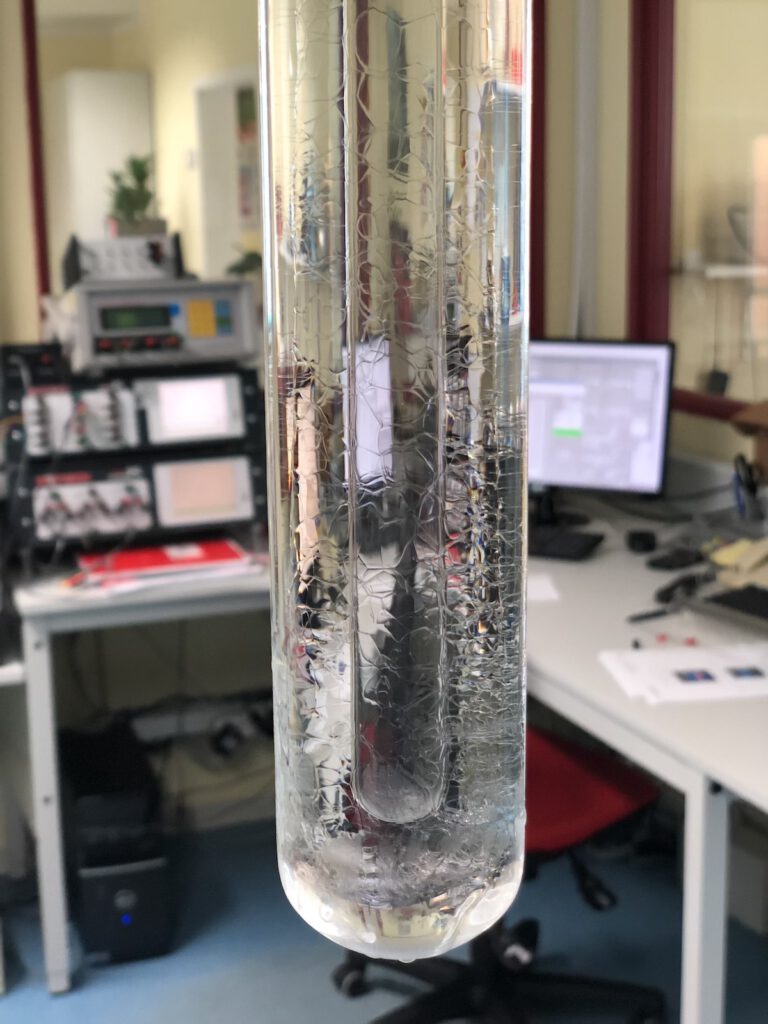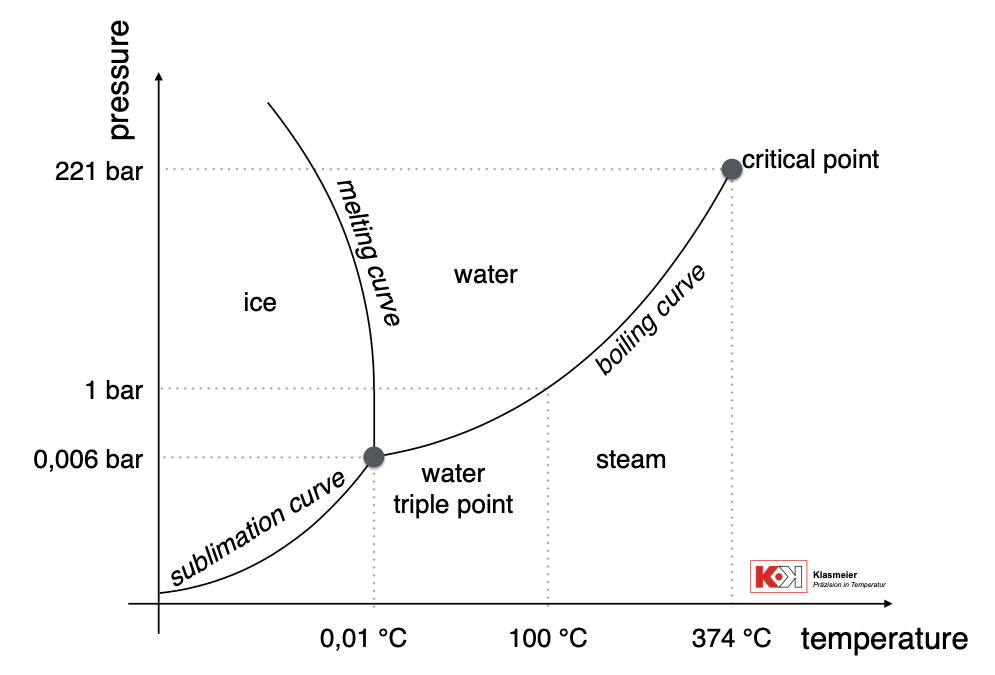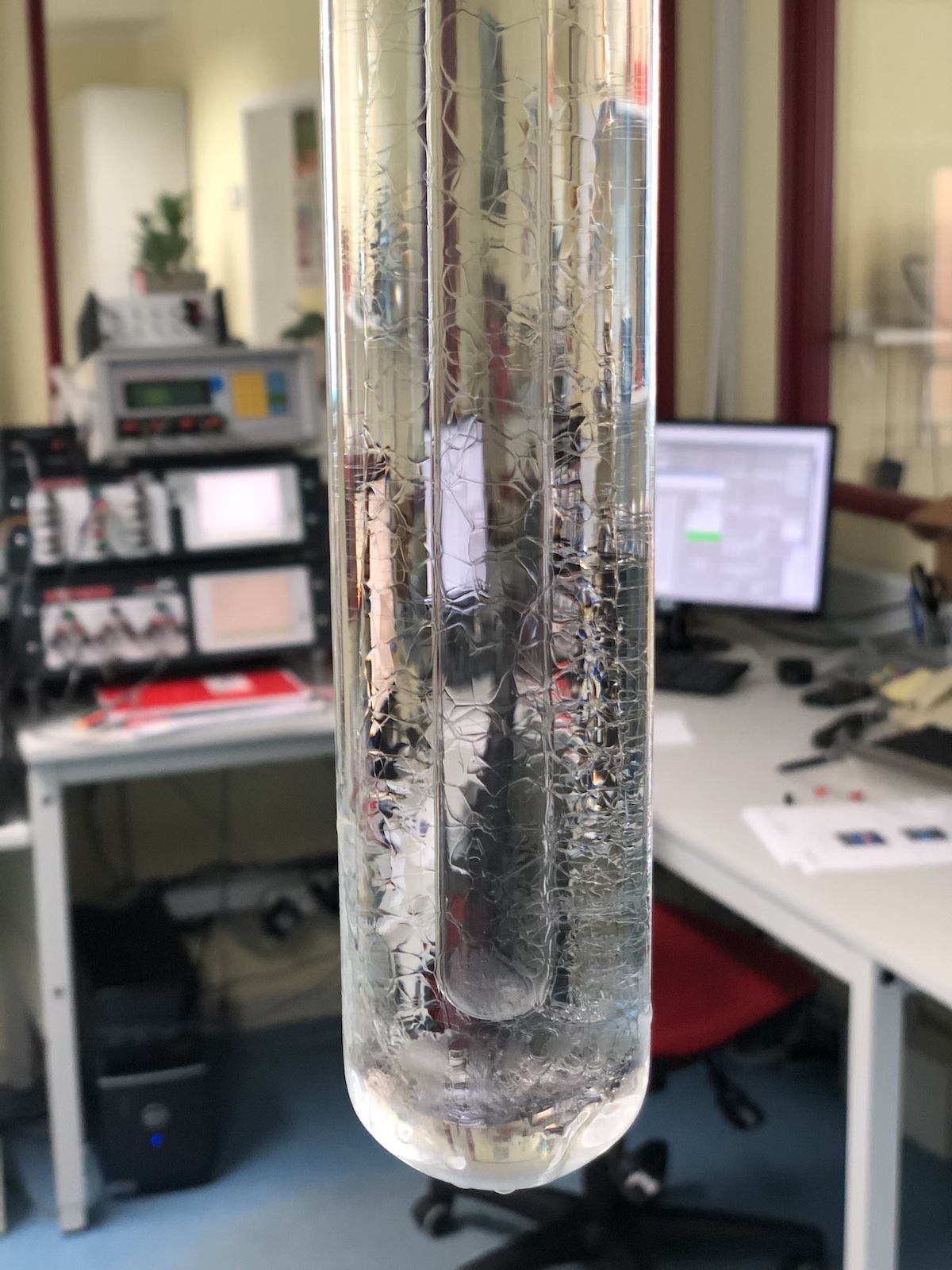The water triple point is a special condition where water exists in the three states of physical aggregation (solid, liquid and gas) simultaneously and in thermodynamic equilibrium. The water triple point is an important reference temperature for the calibration of temperature sensors and thermometers.
Table of Contents

Basic knowledge
The water triple point appears at a certain pressure, normally defined as 611.657 Pa (0.0060366 atm). At this pressure, the temperature at which the three phases of water are in equilibrium is exactly 273.16 Kelvin (0.01°C). This value is the basis for the Kelvin temperature scale, which is an absolute scale where zero is the absolute zero corresponding to the theoretical temperature at which all molecules and atoms of a substance have their minimum energy.
The definition of the water triple point provides a precise and reproducible reference temperature used in the calibration of thermometers and temperature sensors. It is also an important reference temperature for other scientific applications, such as the definition of material constants and for the development of thermodynamic models.
The water triple point in the phase diagram
The water triple point can be recognised in the phase diagram of water. This represents the different conditions (phases) of water under different conditions of pressure and temperature. Water can exist in three main states: solid (ice), liquid (water) and vapour (steam). The phase diagram of water shows under which conditions of pressure and temperature each of these phases is stable.

Important points and curves in the phase diagram of water:
- The water triple point This is where the curves for the solid, liquid and vapour states meet. At this triple point of water, all three phases can exist simultaneously in balance. For water, the triple point is 0.01°C and 611.657 pascals. Since the triple point of water is defined by temperature and pressure, it is an excellent temperature fixed point for calibrating thermometers.
- Melting curve: At the melting curve separates the solid state from the liquid state. Along this line, ice melts into water or water freezes into ice. This phase transition can be used as a secondary fixed point for calibrating thermometers. However, it is pressure-dependent and is around 0 °C.
- Boiling curve: This line separates the liquid state from the vapour phase. Along this line, water evaporates to steam or steam condenses to water. The boiling point can also be used as a secondary fixed point for calibrating thermometers. The boiling point of water at atmospheric pressure is approx. 100 °C.
- Sublimation curve: This line separates the solid from the gaseous state. Along this line, water can sublime directly from solid (ice) to gas (vapour) or reverse without passing through the liquid state.
- Critical point: This point marks the end of the boiling curve. Beyond this point, the liquid and gaseous phases can no longer be separated, and they become a supercritical fluid. For water, this point is about 374°C and a pressure of 22.06 MPa.
What is particularly remarkable about the phase diagram of water is the negative slope of the melting curve. This means that under increasing pressure, the melting point of ice decreases. This is unusual and is different from most other substances. It also explains why ice swims on water.
Realization of the Water Triple Point Cell – “Inner Sheath Method”
The standard method for preparing an ice mantle around the inner sheath of a water triple point cell is the “Inner Sheath Method”. In this method, the ice mantle is formed from the inside out by cooling the inner sheath. Depending on the coolant used (crushed solid CO2, immersion cooler with a heat pipe, rod cooled with liquid nitrogen, or liquid nitrogen), different variants can be applied, summarized as follows:
- Crushed Solid CO2: The inner sheath is filled with crushed solid CO2 up to the water surface in the cell, and more CO2 is added until a mantle of the desired thickness is formed. About 1 ml of ethanol is added before the CO2 to enhance heat transfer and promote a thicker mantle at the bottom.
- Immersion Cooler with Heat Pipe: Initially, about 1 ml of ethanol and 5 ml of finely crushed solid CO2 are placed into the inner sheath to encourage crystal nucleation and a thicker mantle at the bottom, and to protect the water in the cell from supercooling. The immersion cooler is then inserted into the inner sheath, and the space between the inner sheath and heat pipe is filled with ethanol. A heat conduction cycle begins, and the ice mantle forms.
- Rod Cooled with Liquid Nitrogen: The inner sheath is filled with ethanol, and a metal rod pre-cooled in liquid nitrogen is introduced. Several repetitions are necessary to produce an adequate mantle.
- Liquid Nitrogen: This variant can have different sub-variants. Typically, the cold from the liquid nitrogen is transferred into the inner sheath of the water triple point cell through a heat pipe with a cooler.
In all the above-described variants, the water triple point cell must be pre-cooled to a temperature close to 0 °C. During the cooling process, care must be taken to ensure that no solid ice bridge forms at the upper surface. Additionally, it is essential to remove all water from the inner sheath before preparing the ice mantle, for example, by rinsing with high-purity ethanol.
The time required to form an ice mantle depends on the chosen variant: about 30 minutes for variants 1 and 3, 60 minutes or more for variant 2, 10 to 120 minutes for variant 4.
With an alternative, non-standardized method known as the “Mush Method”, the ice mantle is formed from the outside in. Although this method has practical advantages (it can be performed in an industrial temperature block calibrator) and has been shown to match the “Inner Sheath Method” to within 0.1 mK, its use is usually limited to checking the stability of reference SPRTs in secondary temperature calibration laboratories.
Realization of the Water Triple Point Cell – “Mush Method”
As an alternative to the “Inner Sheath Method”, a water triple point cell can also be more economically efficiently realized in a temperature dry block calibrator. This method, known as the “Mush Method”, also allows for extremely precise temperature measurement and can be used in many scientific and industrial applications.
The first step is to carefully place the water triple point cell into the calibration volume of the temperature dryblock calibrator. Then, turn on the temperature dryblock calibrator and set the set point to -8°C. It is important to monitor the temperature with a thermometer in the measuring channel of the water triple point cell during the cooling process. In this context, we recommend using a liquid in the measuring channel of the water triple point cell to optimize heat transfer, for example a mixture of water and ethanol.
When the temperature in the water triple point cell reaches -6°C, the process of ice mantle formation can be initiated. To do this, remove the water triple point cell from the temperature dryblock calibrator, shake it gently, and watch the ice form from the surface of the water to the bottom of the cell. This process causes the temperature in the cell to rise to the triple point of water, which is 0.01°C.
To ensure the stability of the ice-water mixture, the cell can be cooled at -6°C for an additional 45 minutes. It is important to note that during measurements at the water triple point, care must be taken to ensure that the ice mantle does not freeze to the measurement channel or the wall of the cell. If this is the case, you can thaw the ice mantle in the cell using a metal rod and warm the outer mantle using hand heat.
Finally, to maintain the ice mantle of the water triple point cell, the set point of the temperature block calibrator should be set to -1°C. This will ensure that the ice mantle in the cell remains stable and allow accurate measurements.
In summary, setting up a water triple point cell in a -temperature block calibrator is a complex but feasible process. By carefully following the steps presented here, you can make accurate and reliable temperature measurements and have thermometers calibrated.
How water triple points save costs and minimise risks
In the world of precision thermometry, where accurate temperature measurements are essential for a wide range of applications, water triple point cells and gallium melting point cells play a key role.
The use of these fixed temperature points in temperature laboratories, especially for users of standard platinum resistance thermometers (SPRT) or high quality industrial platinum resistance thermometers (PRT) can save costs and minimise risks.
The value of regular checks
While the use of these precision thermometers relies on external calibration by specialised temperature calibration laboratories, the question is: what happens between calibration cycles? Thermometers can be affected during transport or improper handling, which can lead to changes in their values (thermometer drift). Such a change, which is only detected during the next calibration, can have serious consequences, such as the possible invalidation of all previous measurements, which would require a call-back of all calibrated instruments. Such incidents can severely affect confidence in temperature calibration and cause significant costs. However, these risks can be minimised by regular checks of the thermometers at the water triple point and the gallium melting point.
Checks at the water triple point
The calibration certificate of an accredited temperature calibration laboratory will show the last value of the water triple point. After receiving a calibrated thermometer, it should be checked at the water triple point and the result compared with this value. Such a check allows an uncertainty of measurement of less than 0.001°C and is an essential step in ensuring the reliability of the thermometer between calibrations.
The gallium melting point: another way to evaluate thermometer reliability
The Gallium Melting Point allows the resistance value of a thermometer to be measured at 29.7646°C. It is easy to use and offers very low measurement uncertainties. The combination of the gallium melting point and water triple point enables the calculation of the resistance ratio (WGA), a crucial value for assessing the reliability of the thermometer.
This so-called W-value is calculated from the current resistance – in our case the resistance at the gallium melting point R(GA) – and the last known resistance value of the thermometer at the water triple point R(WTP):
W(GA) = R(GA) / R(WTP)
The benefit of the W-value calculation
The W-value is an important quantity in temperature measurement because it practically calculates the characteristic curve of a thermometer. The purer the platinum of the temperature detector of the resistance thermometer, the higher this W-value.
There are certain scenarios that can lead to changes in the performance of the thermometer. Suppose the resistance value of the thermometer at the water triple point increases, but the W-value at the gallium melting point (WGA) remains constant. In such cases, this indicates that the characteristic curve has a parallel shift. This is the classic thermometer drift. This drift effect can happen due to mechanical and thermal stresses. The good news is that such changes are often reversible, and calibration can correct these effects and is therefore useful.
However, if the W-value changes (typically it decreases), this is an indication that the thermometer is contaminated. Unfortunately, such changes are often not reversible and in many cases the thermometer can no longer be calibrated.
Regular checks of the WGA can determine how the thermometer is being stressed in everyday use. These checks can therefore provide a valuable aid to deciding whether or not calibration is reasonable. They can also help to maximise the life and accuracy of the thermometer and prevent unexpected failures.
Advantages of the regular measurement at the water triple point and W-value
The regular measurement of the values R(WTP) (resistance at the water triple point) and W(GA) (ratio of the resistance at the water triple point to the resistance at the gallium melting point) has a number of advantages:
Cost savings: Regular in-house checks allow users to extend calibration periods in accredited, external laboratories, resulting in significant cost savings.
Increased confidence: Regular checks, confirming the accuracy and reliability of the thermometers, will increase the level of confidence in the laboratory.
Avoidance of errors: By identifying and correcting potential problems, erroneous measurements can be avoided that could otherwise lead to serious consequences.
In addition, the use of gallium melting points and water triple points in temperature laboratories allows significant risk minimisation by reducing the need to transport thermometers for external calibrations. This not only saves transport costs, but also minimises the risk of damage to the thermometers.
It is advantageous for users of SPRTs and PRTs to have access to their own water triple point and gallium melting point cells. They allow regular checks and adjustments, increase confidence in the reliability of the thermometers and can reduce the need for external calibrations and associated costs and risks. In a world where precision is critical, water triple points and gallium melting points provide an effective way to ensure accuracy and reliability in thermometry.
Source
- Walter Blanke: Die Internationale Temperaturskala von 1990: ITS-90
- Hering, Martin, Stohrer: Physik für Ingenieure
- Beiz, Grote: Dubbel – Taschenbuch für den Maschinenbau
- Thomas Klasmeier: Tabellenbuch „Temperatur“, Ausgabe 3
- Guide to the Realization of the ITS-90 – Triple Point of Water – Bureau International des Poids et Mesures


